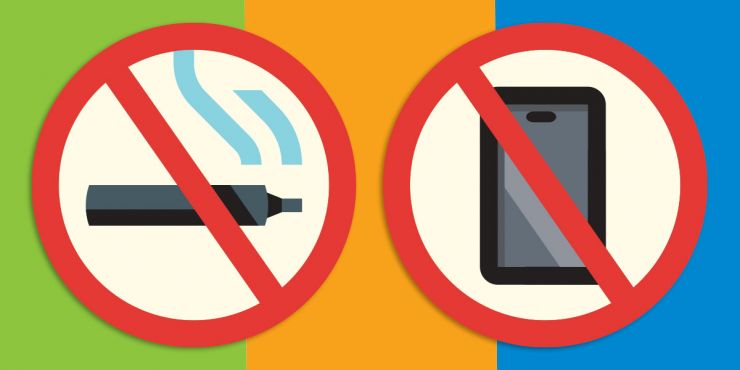
Vaping and Personal Mobile Devices
Effective September 2024, all Ontario school boards will be required to follow the Ministry of Education’s update to the Provincial Code of Conduct to promote healthy and welcoming learning environments. This includes all students being required to follow strict anti-vaping and personal mobile device use guidelines.
When can students use a mobile device?
Students must not use cell phones and other personal mobile devices during instructional time. During instructional time, devices must be turned off or set to silent mode and stored out of view.
- Students in K to Grade 6 can use a mobile device before- and after-school, if permitted based on school policies.
- Students in Grade 7 and 8 can use a mobile device during recess/breaks or lunch, if permitted based on school policies.
- Grade 9 to 12 students can use a mobile device during breaks or lunch.
Students can use their mobile device during learning time only when:
- a teacher says to use it as part of learning, for example, doing research or visiting a specific website.
- it’s needed for a health or medical reason.
- it supports special education needs.
What does the use of mobile devices look like in my child(ren)’s school?
Some schools have had their own policy for the use of mobile devices. Those policies remain in effect if they meet the new minimum requirements of the Ministry of Education.
For the schools without an already established policy, they will adopt the new Ministry requirements. If you have any questions, please check with your child(ren)’s Principal.
Are social media applications banned in Grand Erie schools?
Effective July 1, 2024 the following social media sites will be blocked for students:
| 4chan | Lainchan | Snapchat | Twitch | |
| 8chan | Gab | Parler | Telegram | Twitter/X |
| 8Kun | InfinityChan | TikTok | Voat | |
| Discord | Truth Social | |||
| Endchan | Kiwi Farms | Ruqqus | Tumblr | Wizardchan |
*Subject to be updated
What does this ban on vaping mean for students?
Students cannot bring electronic cigarettes (vapes), tobacco and/or nicotine products to school, including school transportation.
If a student is in possession of an electronic cigarette (vape), tobacco or nicotine product it will be surrendered and disposed of, and parents/guardians will be immediately informed.
Do you have any resources for students who vape?
- School Mental Health Ontario and the Centre for Addiction and Mental Health have compiled resources to find a healthy balance in using technology and screen time at home
- Talking with your teen about vaping: A tip sheet for parents from Health Canada
- Drug Free Kids Canada has a fact sheet with ideas about how to talk to your child about vaping, as well as general information about vaping.
How are the public health units supporting?
The schools are working with their local health unit (Brant County Health Unit or Haldimand-Norfolk Health Unit) to ensure that the Smoke-Free Ontario Act, 2017 is enforced. BCHU has a resource for youth and families who want help with vaping or smoking.
Resources
- Grand Erie letter to families – September 4, 2024
- Ministry of Education - New School Rules: Cellphones, Vaping and Cannabis
- Code of Conduct Procedure SO-012
- Acceptable Use of Information Technology Procedure IT-001
- PPM 128 Provincial Code of Conduct
- Ministry of Education letter to families – April 28, 2024
The Smoke-Free Ontario Act, 2017 prohibits smoking (tobacco and cannabis) and the use of electronic cigarettes (vaping) at schools, on school grounds and all public areas within 20 metres of these grounds. Anyone smoking or vaping on school property is guilty of an offence and if convicted may result in a fine under the Smoke-Free Ontario Act, 2017.
Good Food Adds Up to Good Learning at Courtland Pubic School
Evidence suggests that breakfast and snack programs in schools:
- Improves children’s school performance, memory and test grades
- Enhances students’ physical, emotional, social and intellectual development
- Increases attendance rates, particularly for nutritionally at risk children
- Provides additional time for children to eat and drink nutritious breakfasts and snacks
- Provides energy for students to be more physically
- Enhances nutritional status of students by replacing the consumption of foods with low nutritional value with more nutritious choices, such as more vegetables and fruit
- Promotes a sense of community by bringing people together to ensure all children are well-nourished
- Leads to better dietary habits by increasing the frequency of eating breakfast
- Reduces the prevalence of vitamin and mineral deficiencies
With the generous support of the Child Nutrition Network and the Grand Erie District School Board, the school was able to renovate a room in the school into a nutrition program kitchen. Funds provided by the Child Nutrition Network and school fundraising monies purchase the good food and materials needed to run the program.
Every morning at 8 a.m., parent volunteers and their children arrive to prepare and distribute the food for the day. This program would not happen without their enthusiastic support.
Each serving of food includes a dairy product (i.e. yogurt, cheese string), a grain product (i.e. crackers, mixed cereal, muffin, whole wheat bun) and a fruit product (i.e. apple, banana, clementine orange, grapes, juice) or a vegetable product (i.e. cucumber slices, raw carrots). A container filled with food is delivered to each classroom and as children get settled for a day of learning, staff and students are encouraged to help themselves to a delicious and nutritious start to the day.
“Nutrition programs, such as the one at Courtland Public School, are happening in many schools within the Grand Erie District School Board. It’s a huge effort supported by the Board, volunteers and community agencies. Working together, it’s amazing what can be done. We feel most grateful to have this opportunity for our Courtland school community”, says principal Deb Opersko.
Roots of Empathy
Courtland Public School offers the Roots of Empathy program in our Kindergarten A classroom. Our Early Childhood Educator, Mrs. L. Wildman is a trained Roots of Empathy instructor. Our Roots of Empathy baby and her mom are welcome visitors to the classroom.
An explanation of program, from the Roots of Empathy website is included below:
Roots of Empathy is an evidence-based classroom program that has shown significant effect in reducing levels of aggression among schoolchildren by raising social/emotional competence and increasing empathy. The program reaches elementary schoolchildren from Kindergarten to Grade 8. In Canada, the program is delivered in English and French and reaches rural, urban, and remote communities including Aboriginal communities. Roots of Empathy is also delivered in New Zealand, the United States, Isle of Man, the Republic of Ireland, Northern Ireland and Scotland.
Emotional Literacy
At the heart of the program are a neighbourhood infant and parent who visit the classroom every three weeks over the school year. A trained Roots of Empathy Instructor coaches students to observe the baby's development and to label the baby's feelings. In this experiential learning, the baby is the "Teacher" and a lever, which the instructor uses to help children identify and reflect on their own feelings and the feelings of others. This "emotional literacy" taught in the program lays the foundation for more safe and caring classrooms, where children are the "Changers". They are more competent in understanding their own feelings and the feelings of others (empathy) and are therefore less likely to physically, psychologically and emotionally hurt each other through bullying and other cruelties. In the
Roots of Empathy program children learn how to challenge cruelty and injustice. Messages of social inclusion and activities that are consensus building contribute to a culture of caring that changes the tone of the classroom. The Instructor also visits before and after each family visit to prepare and reinforce teachings using a specialized lesson plan for each visit. Research results from national and international evaluations of Roots of Empathy indicate significant reductions in aggression and increases in pro-social behaviour.More News




